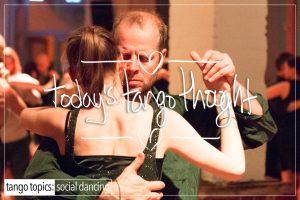Tango music consists of 3 major components: 1.) Beat. 2.) Pause. And 3.) Phrase. In that order, and nothing but that order. Most people get the 1st one, that there’s a beat there, they may not be able to hear it because they’re “Beat Challenged” (or think they are, or have been told that they are, they’re not by the way, it’s a fallacy). The next one most people have never heard of except musicians and it’s the one that takes a little bit of time to hear and then to learn to execute. And yet this is the one that everyone should know because it quite literally defines their dancing! And the last one, Phrases ? Most advanced Tango dancers have heard of this one, the beginner dancer may run across this idea and try to take a class on the topic and wonder and may pick up an idea, but quite honestly very few people understand and can execute this last idea.
Let’s break this down a bit more.
First we have Beat, and this one is really easy to get, or so you would think. This is the one that most people understand that there is a pulse or ‘beat’ to the music. Frequently though they confuse their understanding of Beat for Rhythm or vice versa (and they’re not the same things) – Beat, for clarity, is a component of Rhythm, it is the base building block of the music. Still another confusion is Tempo. Which is the speed at which that beat is played, and thereby the speed of the music. There is the confusion of Tempo for Rhythm, and vice versa, and again, they’re not the same things at all. Tempo is a component in Rhythm but again, not the same thing. Beat is, in layman’s terms, is a linear series of accented or stressed musical notes that are equally distant from each other that occur at the same time, in the same place, every Xth note. Where if you’re counting 1 to 4, X is always 1. It never stops, it never goes away, it never disappears, it’s always there, it’s always constant, and it never changes, ever!
Skipping to the last one – Phrase is a bit more difficult. Hearing the phrases, takes time and patience and is the single hardest thing that you will do. Unfortunately a good portion of teachers have no concerted method for teaching this concept of ‘phrasing’ to hear the ‘phrase’ except for putting shoes on the floor to represent the places where something should happen. The hard part about Phrases is that the method that is usually taught is the repetition method of hearing the same piece of music 10,000 times so that you know it backwards and forwards and can hum along with it. While this method is useful and does have its place, it is exceptionally time consuming. The problem is that it only addresses one side of the equation – The Musical Phrase. So if that’s one side, what’s the other ? Phrasing. Or put simply. A Musical Phrase is what you hear. PhrasING is what you do with that phrase! And again, they’re not the same things, nor are they even close to one another. And yet this is precisely what is ‘taught’. The problem is several fold, which Today’s Tango Thought is not going to drill down into (For the drill down – > See: Teaching Musical Interpretation), however the biggest problem is the method itself, repetition, not to mention the arcane way that music is taught to begin with. There is another method that relies on the brain’s own natural method of cataloguing information and yet this method is not taught. Sadly. Put simply the Musical Phrase is a series of Pauses, which may contain a specific rhythmical element between the Pause elements. Typically Phrases and Phrasing are confused and commingled with each other. And again, they’re not the same things.
It’s the second one that we’re interested in: Pauses.A student once asked “How do you hear something that isn’t ‘there’ ?”. Answer ? You’re listening for a specific ‘marker’ which oddly enough are in every piece of tango music. There 13 ‘markers’ in all, but only 5 of them are very common. That’s how. And once you learn what to listen for, it’s like a world opens up for you. We want and need to listen for those markers from a Leading perspective as well as from a Following perspective, both roles are required to hear the music the same way at the same time! And yet it is this thing, that most people have never heard of except in passing as an afterthought to ‘beat’. While Beat is important to be certain, it’s not the only game in town, and truthfully while you must hear beat, you almost must learn to hear the Musical Pause. Because that Pause IS the MUSICAL PHRASE that you want to begin to play with. However you must be trained to hear those Pauses and the 5 types. This site has that information that you so desperately need. However this is not a sales pitch. It’s simply to point out to you the following facts: 4 out of 10 dancers can not hear the Musical Pause, and 6 out of 10 can not correctly hit every pause. They’ll miss a few, and those few are rather important ones, usually they’re the 4th kind of pause – The Musical Paragraph. And without going into detail about what that is and why it’s important, let’s just say that the Musical Paragraph is the marker that defines an entire piece of music, and there are 4 to 5 in every piece of music, and they have a definitive beginning, middle, and end. And once you hear one, you can’t unhear it.
These items comprise the idea of Tango Music as you understand it. More on this later….











